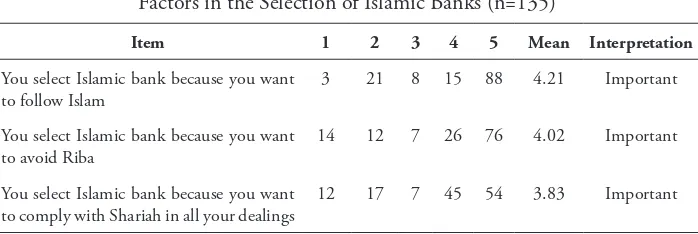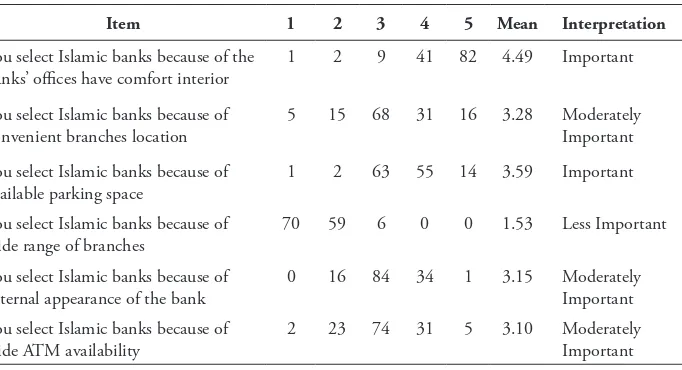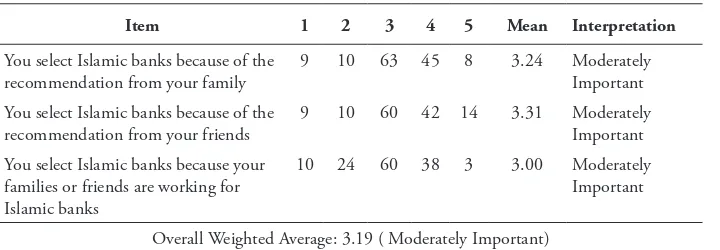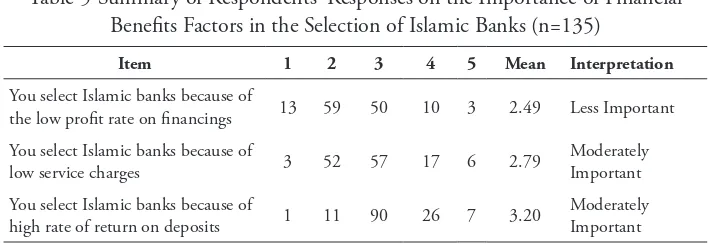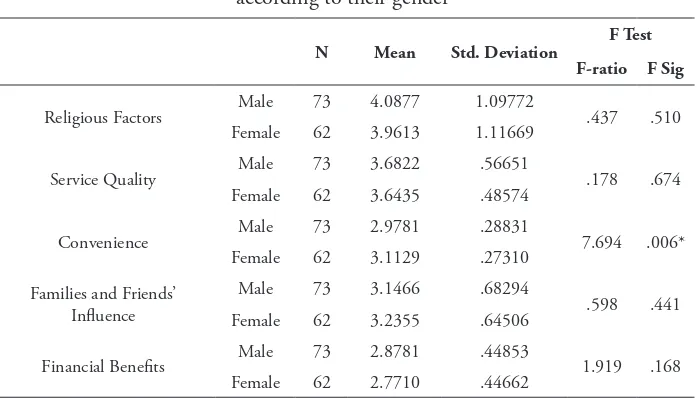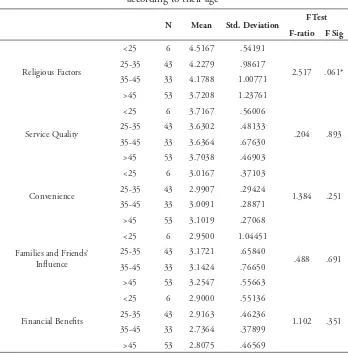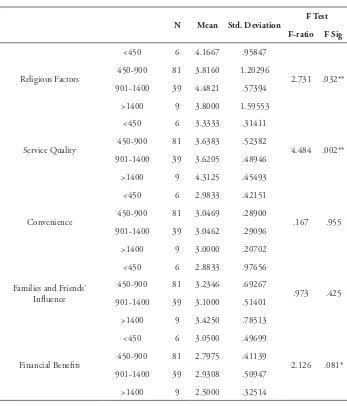Page 165 - 184
Received: January 15, 2017; Revised: February 22, 2017; Accepted: March 21, 2017 1, 2, 3 University College of Bahrain. Po Box. 55040, Saar Manama, Bahrain
THE IMPORTANT SELECTION CRITERIA IN CHOOSING
ISLAMIC BANKS: A SURVEY IN BAHRAIN
Abdulla Hamzah Al-Hadrami1, Sutan Emir Hidayat2, Mohamed Isa Al-Sharbiti3
Abstract. he Important Selection Criteria in Choosing Islamic Banks: A Survey in Bahrain. Selection criteria of banks in general and Islamic banks in particular have been given high attention by the marketing researchers nowadays. But this kind of research is still insuicient in numbers especially in the developing countries. herefore, this study aims to identify the important selection criteria that are considered by customers in selecting Islamic banks in the Kingdom of Bahrain. A 5-Likert scale survey questionnaire and ANOVA were used as the research method. he results indicate that the religious factors were ranked as the most important selection criteria for selecting Islamic banks. he study also found service quality factors as the second important selection criteria. his study is expected to provide Islamic banks in Bahrain with some inputs in setting up their marketing strategies in order to attract new customers and retain their existing customers. his study is also expected to add value to the literature by providing the updated empirical study in the area.
Keywords: selection criteria, customers, Islamic banks
Abstrak. Kriteria Pemilihan Utama dalam Menentukan Bank Syariah: Survei di Bahrain. Kriteria pemilihan bank secara umum maupun bank syariah secara khusus telah banyak dilakukan oleh para penelitian di bidang pemasaran saat ii. Akan tetapi, penelitian ini belum banyak dilakukan di negara berkembang. Penelitian ini bertujuan untuk mengidentiikasi kriteria pemilihan utama yang dipertimbangkan oleh nasabah dalam memilih bank syariah di Bahrain. Metode yang dipergunakan ialah kuesioner dengan skala likert dan ANOVA. Hasil menunjukkan bahwa faktor agama merupakan kriteria pemilihan utama dalam memilih bank syariah. Selain itu, penelitian ini juga menemukan bahwa faktor kualitas layanan menjadi kriteria pemilihan utama kedua. Penelitian ini diharapkan mampu memberikan kontribusi bagi bank syariah di Bahrain dalam menetapkan strategi pemasaran dalam kaitannya menarik nasabah baru dan mempertahankan nasabah lama. Selain itu diharapkan pula penelitian ini mampu memberikan pembaharuan literature terkait studi sejenis.
Introduction
Despite Islam requires its followers to comply all aspects of their life including the inancial matters with sharia, Islamic banking and inance was still unknown and unheard before 1970s. he momentum that led to the current development took place when the historical conference for the rulers in the Islamic world held on 25th September 1969 in Rabat, Kingdom of Morocco. he rulers have made the decision to establish the Organization of Islamic Conference (OIC), whose purpose was to unite the Muslim voice across the world and safeguard the concerns of the Muslim world in the spirit of promoting international peace and harmony among various people of the world (Mullineux & Murinde, 2003). One of the results of the establishment of the OIC was the establishment of Islamic Development Bank (IDB).
Since that, Islamic Banks continued to grow and expand in size and in numbers. Currently, there are more than three hundreds Islamic inancial institutions in over ifty-one countries with the total assets in 2013 had reached USD 1.3 Trillion (Izhar and Rehman, 2014). his gives an indication that this industry is growing quickly and sharply. he growth of this business is tremendous in comparison to other aspects of the inancial industry (Ali, 2011).
One of the important countries to the development of Islamic banking and inance is Kingdom of Bahrain. Bahrain is known as the inancial center of the Middle East. he inancial service sector is among the highest contributors to the country’s overall GDP. he sector represents around 27% of GDP of the country. In addition, the inancial service is the largest sector that absorbs the workforce in Bahrain. Up to September 2014, the number of inancial institutions in the country is 404 and the total workforce is 14,0091.
Up to December 2014, there are 6 Islamic retail banks and 18 Islamic wholesale banks operating in the kingdom. he high numbers of Islamic banks shows high proile of the country as one of the worlds’ leading Islamic inancial centers. he importance of Islamic banking can be further substantiated with the increasing contribution of Islamic banking assets to the total banking system. he growth of Islamic banking in particular has been remarkable during 2000-2008, with total assets in this segment jumping from USD 1.9 billion in 2000 to USD 27.12 billion at the end of 2008, an increase of over 500%. he market share of Islamic banks correspondingly increased from 1.8% of total banking assets in 2000 to around 13.3% in 20122. As the Islamic banking grows in the Kingdom, Islamic
banks need to recognize and realize the selection criteria that inluence customers’
1 http://www.cbb.gov.bh/page-p-overview1.htm. It was accessed on 17/12/2014.
selection of Islamic banks. Understanding the selection criteria will enable them to increase their number of customers and thus the inancial transactions performed. his will positively afect the banks’ proitability.
Based on the above background, this study aims to identify the important selection criteria that are considered by customers in selecting Islamic banks in the Kingdom of Bahrain. In other words, this study aims to answer the following research questions: First, what are the important selections criteria considered by the customers in the process of selecting Islamic banks? Second, Do demographic variables signiicantly inluence the selection criteria of Islamic banks?
his study is expected to provide Islamic banks in Bahrain with some inputs in setting up their marketing strategies in order to attract new customers and retain their existing customers. his study is also expected to add value to the literature by providing the updated empirical study in the area. he current study extends and complements the study of Metawa and Al-Mossawi (1998) by investigating the importance of other selection criteria which are not examined in that study, namely service quality and other convenience factors including comfort interior, the availability of parking space, the availability of wide range of branches and ATMs, and external appearance. Moreover, the current study tested the inluence of gender on the selection criteria variables that have not been tested by Metawa and Al-Mossawi study. his demographic variable is considered an important factor that afects the customer’s Bank selection.
Some indings of the current study are consistent with the indings of the previous studies and some indings are contrary to the indings of previous studies. Understanding the selection criteria which relect the perceptions of the Islamic banks’ customers is important for Islamic banks’ stakeholders because these selection criteria determine how and to what extent customers choose to patronize the alternative products and services of the banks (Gait and Worthington, 2007).
Literature Review
Dusuki and Abdullah (2006), investigated why customers patronize Islamic banks in Malaysia. he study was based on a sample of 750 respondents. he study found that the most important selection criteria in accepting Islamic banks are service quality, friendly staf, bank reputation, and Islamic working environment. Khan et al. (2007) conducted a study to investigate banks’ selection criteria in Islamic banks in Bangladesh, based on a sample of 100 customers of Islamic banks who completed a questionnaire, and found that the most important selection criteria among Islamic banks’ customers is the religious principles. Ranjbar and Sharif (2008) investigated on Islamic banking selection criteria in Malaysia, using data from 150 questionnaires completed by Muslim and non-Muslim customers. he study results indicated that there is no signiicant diference in the selection criteria between Muslim and non-Muslim customers. he key factors in selecting inancial institutions were the provision of fast and eicient service, conidentiality of banks, bank reputation and image, provision of a wide range of services, lower proit rates on inancings and the friendliness of bank personnel. Hague et al. (2009) investigated the major factors inluencing the selection of Islamic banking in Malaysia, based on data collected from 485 customers through questionnaires. he study found that the factors inluencing Islamic banking customers are quality of services, availability of services, social and religious perspectives and customers’ conidence in the bank.
Bhatti et al. (2010) surveyed 120 customers in Pakistan. he study’s results indicate that the main selection criteria of an Islamic bank are religiosity and proitability, eiciency and speed in completing transactions, and staf friendliness. Farooq et.al. (2010) studied the selection criteria of Islamic customers patronizing a particular bank in Afghanistan. he sample was based on 100 questionnaires. he study found that the most important factors leading to the customer’s choice of Islamic banking products/services are religious reliance, recommendation of family and friends, easy access to branch, and proitability of the bank.
In general, review of literature reveals that religious factors, quality of services performed by the Islamic banks, convenience, family and friends’ inluence, and inancial beneit play major roles in the selection process and become the main selection criteria of Islamic banks. Using the above selection criteria, this study attempts to extend Metawa and Al-Mossawi (1998)’s study by conducting the updated survey in Bahrain in order to identify the important selection criteria that afect customers’ selection of Islamic banks. In general, most of the previous studies including Metawa and Al-Mossawi (1998) did not test the diferences among the respondents’ opinion based on their demographic variables. herefore, this study examined the signiicant diferences in the respondents’ opinion about the selection criteria of Islamic banks when the respondents are grouped according to gender, age, level of education, and level of income to ill the gap in the literature.
Method
Based on the above previous studies, it is found that most studies related to selection criteria of Islamic banking services used a 5-Likert scale survey questionnaire as their research method. A survey questionnaire is a kind of quantitative research approach. herefore, this study uses the same method as the previous studies (Metawa and Al-Mossawi, 1998; Dusuki and Abdullah, 2006; Khan et al, 2007; Ranjbar and Sharif, 2008; Hague et al, 2009; Bhatti et.al, 2010; Farooq et al, 2010; Abduh and Omar, 2012; Hidayat and Al-Bawardi, 2012). he questionnaire used to collect the data for this study was developed based on the questionnaire of the above previous studies.
he items in the questionnaire are divided into 6 groups. he irst group collects demographic proile of the respondents in terms of gender, age, level of education and level of income. he second group collects information about the respondents’ opinion on the importance of religious factors as selection criteria of Islamic banks. here are 3 items under the category namely “You select Islamic bank because you want to follow Islam”, “You select Islamic bank because you want to avoid Riba”, and “You select Islamic bank because you want to comply with Shariah in all your dealings”.
there are 6 items namely “You select Islamic bank because of the bank’ oices have comfort interior”, “You select Islamic bank because of convenient branches location”. “You select Islamic bank because of available parking space”, “You select Islamic bank because of wide range of branches”, “You select Islamic bank because of external appearance of the bank” and “You select Islamic bank because of wide ATM availability”.
he ifth group collects information about the respondents’ opinion on the importance of families and friends’ inluence as the selection criteria of Islamic banks. here are 3 items under this category namely “You select Islamic bank because of the recommendation from your family”, “You select Islamic bank because of the recommendation from your friends” “You select Islamic bank because your families or friends are working for Islamic banks”. he sixth group collects information about the respondents’ opinion on the importance of inancial beneits as the selection criteria of Islamic banks. here are 3 items under this category namely “You select Islamic bank because of the low proit rate on inancings”, “You select Islamic bank because of low service charges” and “You select Islamic bank because of high rate of return on deposits”.
he population of this study consists of all customers of Islamic commercial banks in Bahrain. Convenience sampling was used since this technique is widely used for exploratory research, which involves samples drawn from part of population using a random approach. It simply gathers data from people who are readily available and accessible. 150 questionnaires were distributed to Islamic banks’ customers. However, only 135 questionnaires were completely illed up and returned.
Analysis of Variance (ANOVA) test was applied to determine if there are any signiicant diferences in the average weighted means obtained by the responses of the respondents when they are grouped according to the gender, age, level of education, and level of income. According to Hair et al. (2010) ANOVA is a technique used to determine whether two or more groups come from a population difer signiicantly or not in terms of a speciic variable. he usage of ANOVA for the purpose of testing signiicant diferences in the average weighted mean has been used by some previous studies with diferent objectives.(Hidayat and Al-Hadrami, 2015; Al-Hadrami and Hidayat, 2015.)
Result and Discussions
Demographic proiles
old. 33 (24.4%) of them are in the range of 36-45 years old. he remaining 53 respondents (39.3%) are above 45 years old. In term of education, 1 respondent did not complete high school (0.7%). 12 respondents (8.9%) are high school graduates, 119 respondents (88.1%) hold bachelor degree and 3 respondents (2.2%) are holding postgraduate degrees. In term of income, 6 respondents (4.4%) have monthly income below BD 450. 81 (60%) respondents have monthly income in the range of BD 450-900. 39 (28.9%) respondents earn in the range of BD 901-1400 monthly and the remaining 9 respondents (6.6%) earn above BD 1,400 monthly.
Importance of religious factors as the selection criteria for Islamic banks
Table 1 summarizes the respondents’ responses regarding the importance of religious factors in the selection of Islamic banks. As seen in this Table the overall average of the respondents’ responses regarding the religious factors is 4.02, with a verbal interpretation of “Important”. In addition, the average responses regarding the three elements of this category have a verbal interpretation of “Important”. “Following Islam” has the highest average score (4.21), followed by “Avoiding riba”, with an average score of 4.02 and “compliance with sharia”, with an average score of 3.83. he indings indicate that religious factors viewed as important selection criteria of Islamic banks by Islamic bank customers in Bahrain.
Table 1. Summary of Respondents’ Responses on the Importance of Religious Factors in the Selection of Islamic Banks (n=135)
Item 1 2 3 4 5 Mean Interpretation
You select Islamic bank because you want to follow Islam
3 21 8 15 88 4.21 Important
You select Islamic bank because you want to avoid Riba
14 12 7 26 76 4.02 Important
You select Islamic bank because you want to comply with Shariah in all your dealings
12 17 7 45 54 3.83 Important
Overall Weighted Average: 4.02 (Important)
Importance of service quality factors as the selection criteria for Islamic banks
Table 2 shows that the overall average of the respondents’ responses regarding the service quality factors is 3.66, with a verbal interpretation of “Important”. In addition, the average responses regarding the three elements of this category each has a verbal interpretation of “Important”. “High quality of customer services” has the highest average score (3.73), followed by “fast and eicient service”, with an average score of 3.69, and “accuracy in service transaction”, with an average score of 3.57. he above indings indicate that service quality plays an important role in the selection process of Islamic banks (important selection criteria). Table 2 summarizes the respondents’ responses regarding the importance of service quality factors in the selection of Islamic banks.
Table 2-Summary of Respondents’ Responses on the Importance of Service Quality Factors in the Selection of Islamic Banks (n=135)
Item 1 2 3 4 5 Mean Interpretation
You select Islamic bank because of fast and eicient service
3 12 41 47 32 3.69 Important
You select Islamic bank because of accuracy in service transaction?
1 6 59 53 16 3.57 Important
You select Islamic bank because of high quality of customer services
0 7 48 54 26 3.73 Important
Overall Weighted Average: 3.66 (Important)
herefore, Islamic banks management needs to pay attention to this aspect. he indings of this study conirm the indings of the previous studies (Dusuki and Abdullah, 2006; Ranjbar and Sharif, 2008; Hague et al, 2009; Bhatti et.al, 2010; Abduh and Omar, 2012; Hidayat and Al-Bawardi, 2012).
Importance of convenience factors as the selection criteria for Islamic banks
Table 3-Summary of Respondents’ Responses on the Importance of Convenience Factors
Item 1 2 3 4 5 Mean Interpretation
You select Islamic banks because of the banks’ oices have comfort interior
1 2 9 41 82 4.49 Important
You select Islamic banks because of convenient branches location
5 15 68 31 16 3.28 Moderately
Important
You select Islamic banks because of available parking space
1 2 63 55 14 3.59 Important
You select Islamic banks because of wide range of branches
70 59 6 0 0 1.53 Less Important
You select Islamic banks because of external appearance of the bank
0 16 84 34 1 3.15 Moderately
Important
You select Islamic banks because of wide ATM availability
2 23 74 31 5 3.10 Moderately
Important
Overall Weighted Average: 3.19 (Moderately Important)
Meanwhile, “convenient branch location” is categorised as “Moderately important”, with an average score of 3.28, followed by “external appearance of the bank” with an average score of 3.15 and “wide ATM availability” with an average score of 3.10. Both external appearance and wide ATM availability are regarded as “Moderately important”. Finally, “wide range of branches”, with an average score of 1.53, is the least important factor in this category with verbal interpretation of “Less important”. Although the overall result indicates that convenience is not as important as religious and service quality factors, it does not mean the factors under this category are to be ignored. In fact, 2 factors under these categories regarded as important selection criteria by Islamic bank customers.
he overall indings for this category are not in line with some previous studies that consider this category as important selection criteria of Islamic banks (Metawa and Al-Mossawi, 1998; Khan et al, 2007; Farooq et al, 2010; Hidayat and Al-Bawardi, 2012). Table 3 below summarizes the respondents’ responses regarding the importance of convenience factors on the selection of Islamic banks.
Importance of families and friends’ inluence factors as the selection criteria for Islamic banks
addition, the average responses regarding the three elements of this category have a verbal interpretation of “Moderately important”. “Recommendations from friends” has the highest average score (3.31), followed by “recommendation from your family” with an average score of 3.24, and “friend/family members working for the Islamic banks” with an average score of 3.00.
Despite families and friends’ inluence factors are regarded as important selection criteria by some previous studies (Metawa and Al-Mossawi, 1998; Farooq et al, 2010), this study found that Islamic bank customers in Bahrain are in the opinion that these factors are not as important as religious and service quality factors. In addition, none of the items under this category obtained verbal interpretation of “Important”. Table 4 summarizes the respondents’ responses regarding the importance of families and friends’ inluence in the selection of Islamic banks.
Table 4-Summary of Respondents’ Responses on the Importance of Families and Friends’ Inluence Factors in the Selection of Islamic Banks (n=135)
Item 1 2 3 4 5 Mean Interpretation
You select Islamic banks because of the recommendation from your family
9 10 63 45 8 3.24 Moderately
Important
You select Islamic banks because of the recommendation from your friends
9 10 60 42 14 3.31 Moderately
Important
You select Islamic banks because your families or friends are working for Islamic banks
10 24 60 38 3 3.00 Moderately
Important
Overall Weighted Average: 3.19 ( Moderately Important)
Importance of inancial beneits factors as the selection criteria for Islamic banks
Table 5-Summary of Respondents’ Responses on the Importance of Financial Beneits Factors in the Selection of Islamic Banks (n=135)
Item 1 2 3 4 5 Mean Interpretation
You select Islamic banks because of
the low proit rate on inancings 13 59 50 10 3 2.49 Less Important
You select Islamic banks because of
low service charges 3 52 57 17 6 2.79
Moderately Important
You select Islamic banks because of
high rate of return on deposits 1 11 90 26 7 3.20
Moderately Important
Overall Weighted Average: 2.82 ( Moderately Important)
he inding is not in line with some previous studies that found these factors as important selection criteria of Islamic banks (Metawa and Al-Mossawi, 1998; Khan et al, 2007; Ranjbar and Sharif, 2008; Hidayat and Al-Bawardi, 2012).
Testing for signiicant diferences in the opinions by demographic proile
he current study employed analysis of variance (ANOVA) at a 90% level of conidence to test for any signiicant inluence of demographic variables on the selection criteria discussed above. ANOVA was conducted to identify any statistical signiicance in the diferences between sample elements’ responses when they are grouped based on their gender, age, level of education and level of income. Table 6 summarizes the ANOVA outputs when the respondents are grouped according to their gender.
friends in selecting Islamic banks as being greater than did male customers, with mean scores of 3.2355 and 3.1466 respectively. Finally, in terms of the inancial beneits, the results indicated that male customers perceived the factors to be more important than did females (with mean scores of 2.8781 and 2.7710 respectively).
Table 6-Summary of ANOVA outputs when the respondents are grouped according to their gender
N Mean Std. Deviation F Test
F-ratio F Sig
Religious Factors Male 73 4.0877 1.09772 .437 .510
Female 62 3.9613 1.11669
Service Quality Male 73 3.6822 .56651 .178 .674
Female 62 3.6435 .48574
Convenience Male 73 2.9781 .28831 7.694 .006*
Female 62 3.1129 .27310
Families and Friends’ Inluence
Male 73 3.1466 .68294
.598 .441
Female 62 3.2355 .64506
Financial Beneits Male 73 2.8781 .44853 1.919 .168
Female 62 2.7710 .44662
* P < 0.10
When the respondents are grouped according to their age, ANOVA outputs reveal that the only signiicant diference was found for the religious factors, which was perceived to be signiicantly more important in selecting Islamic banks than other elements by respondents aged below 25, with an average score of 4.51, while respondents aged 25-35 years, 35-45 years, and more than 45 years had average scores of 4.22, 4.17, and 3.72 respectively. One possible reason is due to exposure of these age groups to Islamic inance courses at their universities. his inding is consistent with the indings of each of Bhatti et.al. (2010) and Farooq et al. (2010) who found a signiicant relationship between age and the religious factor.
inancial beneits, the results revealed that respondents aged 25-35 years had the highest average score of 2.91.However, none of them are statistically signiicant.
When the respondents are grouped according to their level of education, ANOVA outputs reveal that the only signiicant diference was found for the inluence of family and friends, for which the inluence is signiicantly high for those with below high school and postgraduate degree, with an average score of 4. his inding conirms the results of each of Metawa and Al-Mossawi (1998) and Bhatti et.al. (2010) who found a signiicant relationship between the education level of the respondent and the family and friends recommendation in selecting banks.
Table 7-Summary of ANOVA outputs when the respondents are grouped according to their age
N Mean Std. Deviation F Test
Table 8-Summary of ANOVA outputs when the respondents are grouped according to their level of education
N Mean Std.
Deviation F Test
F-ratio F Sig
Religious Factors Below High School 1 4.7000 1.707 .169
High School 13 3.5083 1.23984
Bachelor Degree 119 4.0966 1.06643
Postgraduate Degree 3 3.2333 1.74738
Service Quality Below High School 1 3.7000 .450 .718
High School 12 3.7083 .40330
Bachelor Degree 119 3.6513 .53991
Postgraduate Degree 3 4.0000 .70000
Convenience Below High School 1 3.0000 .056 .983
High School 12 3.0500 .33166
Bachelor Degree 119 3.0378 .28789
Postgraduate Degree 3 3.1000 .26458
Families and Friends’
Inluence Below High School
1 4.0000 2.186 .093*
High School 12 3.0750 .76053
Bachelor Degree 119 3.1714 .65122
Postgraduate Degree 3 4.0000 0.00000
Financial Beneits Below High School 1 2.7000 .727 .537
High School 12 3.0083 .44611
Bachelor Degree 119 2.8134 .45003
Postgraduate Degree 3 2.7667 .50332
As seen in Table 8, religious factors are more important for Islamic bank customers with low level of education than those with higher education as relected by the highest score obtained by the respondent with no high school (4.7). In terms of service quality, respondents with postgraduate degree had the highest average score (4.00). It means those with high education tend to care more about service quality factors than others. However, the diference is not statistically signiicant. With regards to convenience, respondents with post graduate degree obtained the highest score (3.1). It means those with high education tend to care more about convenience factors than others. However, the diference is not statistically signiicant. Finally, in terms of inancial beneits, the result shows that respondents with high school degree have the highest average score (3.00). Table 8 summarizes the ANOVA output when the respondents are grouped according to their level of education.
When the respondents are grouped according to their level of income, ANOVA outputs reveal that there are signiicant diferences in each of religious, service quality, and inancial beneits factors. Respondents in the higher income bracket (901-1400) cited religious factors as the most important element with an average score of 4.48. his inding is consistent with the inding of Metawaa and Al-Mossawi (1998) who found a signiicant relationship between the respondents’ income and the religious factor. Additionally, as seen in Table 9 those with income more than 1400 gave an average score of 4.31 for service quality. It means as higher the income as more the requirements for service quality. For inancial beneits, respondents with income less than 450 gave the highest average score of 3.05 which indicates as less the income as more interest in the inancial beneits they can get from the bank. Finally, as it can be seen in Table 9, in terms of other factors, respondents with income between 450 and 900 gave the highest average score for convenience (3.04), and for family and friends’ inluence, those with income greater than 1400 income gave an average score of 3.42. Table 9 summarizes the ANOVA output when the respondents are grouped according to their level of income.
score of 3.19. his means that the Islamic banks must give more attention to the internal and external interiors to make them more attractive. In the fourth rank comes the importance of families and friends’ inluence also with overall average scores of 3.19. However, it is ranked fourth since no factor under this category obtained average scores with verbal interpretation of “Important”. In the last rank come inancial beneits, with an overall average score of 2.82.
he descriptive statistics shows that the overall average scores for religious factors and service quality factors are categorized as “Important”. his inding is in line with indings of Metawa and Al-Mossawi (1998) and Khan et al. (2007), Hague et al. (2009), Bhatti et.al (2010), Farooq et al. (2010), Abduh and Omar (2012), and Usman (2015). herefore, these are the two most important selection criteria of Islamic banks according to Islamic bank customers in Bahrain. In addition, two factors of convenience namely comfort interior and available parking space are also regarded as important selection criteria, which are not identiied by Metawa and Al-Mossawi (1998). his is probably due to the new development in the banking industry between 1998 and 2015 where competition among the banks is tougher than before which requires Banks to pay attention into those factors. In addition, the life style of the people in Bahrain and the Gulf countries in general has changed to more luxurious style.
Table 10. Factors rank according to the respondents’ responses
Rank Factor Overall Average (OA)
1 Religious factors 4.02
2 Service quality 3.66
3 Convenience 3.19
4 Families and friend’s inluence 3.19
5 Financial beneits 2.82
Several analyses of variance (ANOVA) were conducted to determine the impact of the demographic variables (gender, age, level of education, and level of income) on the study factors (religious, service quality, families and friends’ inluence, convenience, and inancial beneits). Table 11 summarizes the ANOVA results.
Table 11-Summary of the ANOVA test results
Demographic Variables Signiicant diferences among respondents
Gender Convenience factors
Age Religious factors
Level of education Families and friends’ inluence factors
Conclusion
he indings of this study have met the objectives of the study. he most important factors that inluence the decision of customers when they select Islamic banks have been identiied. he indings reveal that when the respondents are grouped according to their gender, the only signiicant diference among respondents is for the convenience factors, and when the respondent are grouped according to their age, the only signiicant diference among respondents is for the religious factors. Moreover, when the respondent are grouped according to their level of education, the only signiicant diference among respondents is for families and friends’ inluence, and when the respondent are grouped according to their level of income, there were signiicant diferences among respondents for religious, service quality, and inancial beneits factors.
Based on its indings, the study also comes out with the following recommendations: First, the customer relations department should seek to improve customer relationship by considering the most important selection criteria of Islamic banks namely religious and service quality factors. Second, special care should be taken to ensure that bank branches are conveniently located, that their interior is comfortable and that there is parking available, as these are also considered to be important factors. hird, human resource departments should perform continuous training programs to maintain “fast, eicient, accurate and high quality” services, as they are considered to be important selection criteria.
References
Abduh, M., & M.A. Omar. (2012). Islamic Bank selection criteria in Malaysia: An AHP Approach. Business Intelligence Journal, 5(2): 217-281.
Al-Hadrami, A. & S. Hidayat. (2015). Obstacles to Integrating Forensic Accounting in the Accounting Curriculum: he Case of Bahrain. Global Review of Accounting and Finance, 6(1): 165-175.
Ali, S. S. (2011). Islamic Banking in the MENA Region,. Jeddah: he World Bank and Islamic Development Bank-Islamic Research and Training Institute. Bhatti, G. et.al. (2010). Determinants of Customer Satisfaction and Bank Selection
in Pakistan. Interdisciplinary Journal of Contemporary Research in Business, 2(6): 536-544.
Dusuki, A., & N. Abdullah. (2006). Why do Malaysian Customers Patronize Islamic Banks? International Journal of Bank Marketing, 25(3): 142-160. Farooq, U. et.al. (2010). Proile Analysis of the Customers of Islamic Banking in
Peshawar, Pukhtunkhwa. International Journal of Business and Management,, 5(11): 106-117.
Gait, A. & A. Worthington. (2007). An Empirical Survey of Individual Consumer, Business Firm and Financial Institution Attitudes towards Islamic Methods.
Working Paper. School of Accounting and Finance, University of Wollongong.
Hague, A. et.al. (2009). Factor Inluences Selection of Islamic Banking: A Study on Malaysian Customer Preferences. American Journal of Applied Sciences, 6 (5): 922-928.
Hair, J. et.al. (2010) Multivariate data analysis. 7th ed, Englewood Clifs: Prentice Hall.
Hidayat, S. E. (2010). Islamic Finance: he Original Wisdom Behind its Establishment. Islamic Finance News, 7(31): 23-30.
Hidayat, S. E. & N.K. Al-Bawardi. (2012). Non Muslims’ Perceptions Toward Islamic Banking Services in Saudi Arabia. Journal of US-China Public Administration, 9 (6): 654-670.
Hidayat S. & A. Al-Hadrami. (2015). Forensic Accounting Education in Bahrain: A survey on Educators’ Opinion. International Journal of Pedagogical Innovations, 3 (1): 7-16.
Izhar, H. & Y. Rehman. (2014). Global Islamic Finance Outlook 2014. Islamic
Finance News, 11(3): 25-26.
Khan, M. et.al. (2007). Banking Behavior of Islamic Bank Customers in Bangladesh.
Metawa, S. & M. Al-Mossawi. (1998). Banking Behavior of Islamic Bank Customers: Perspectives and Implications. International Journal of Bank Marketing, 6(5): 299-313.
Mullineux, A. & V. Murinde. (2003). Handbook of International Banking.
Cheltenham, UK and Northampton, USA: Edward Elgar.
Ranjbar, A. & S. Sharif. (2008). Islamic Banking Selection Criteria: An Empirical
Study in Malaysia. Kuala Lumpur: SSRN.com, 1898663.
Usman, H. (2015). he Role of Religious Norms on Selecting he Islamic Bank.
